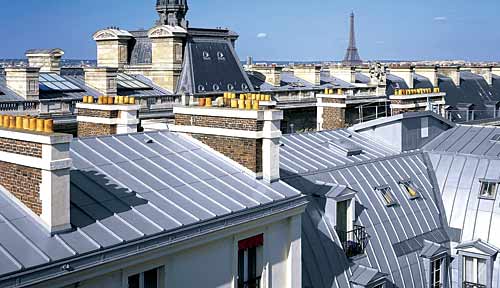Architectural Zinc: From Gray to Green
Learning Objectives:
- Identify zinc's chemical and physical properties related to sustainable building.
- Discuss the reasons for architectural zinc's long-term durability and inherent recyclability.
- Examine the environmental profile of architectural zinc through its entire life cycle.
Credits:
When Baron Haussmann renovated Paris for Napoleon III beginning in 1853, he used zinc extensively, and the beautiful rooftops of today's Paris are still over 80 percent zinc. Now architects are turning to this long-used traditional material for reasons far beyond its storied past. Unbeknownst to the Baron, zinc has chemical and physical properties which make it one of the most environmentally benign building materials available, virtually 100 percent recyclable and ecologically friendly at every step in its life cycle.
Though known for generations in Europe for its beauty, versatility and extreme durability, the concept of zinc as a green building material playing a positive role in the environment may be less familiar. The characteristics that set architectural-grade zinc apart from other metals, and in fact from many other building materials, are just now beginning to be part of the environmental calculation in the United States.
This article will illustrate the environmental profile of architectural-grade zinc alloys-used in buildings for roofs, facades, and rainwater systems-over their entire life cycle, from production through use and re-use. The focus will be on how zinc's chemical and physical properties, the history and technology of its long-term durability, and its inherent nearly 100 percent recylability qualify this metal as a green material.
Essential Element
Zinc is present throughout the natural environment, in the earth, air and water. Zinc is essential to all life, a fundamental part of the metabolic processes of plants, animals and humans. In the human body, over 300 enzymes require zinc for proper functioning. Zinc is already an ingredient in vitamins, supplements, cold lozenges, toothpaste and other pharmaceuticals, and positive effects on human health in areas such as anti-oxidant activity, eye health, disease and aging prevention and many others are being intensively studied.
Ingesting a heavy metal to improve your health might seem counterintuitive, because the term "heavy" is often read as "toxic." But the definition of "heavy" actually refers only to specific gravity, a term relating to the heaviness of a substance compared to that of water. "Heavy" metals have a density of over 5 g/cm3 and light metals less than that. Some heavy metals, such as lead, are toxic. Others, like zinc, are distinctly non-toxic, a trace element that is indispensable for all living organisms.
|
The essential nature of zinc means that run-off from today's zinc building material is clear and safe. In fact, zinc is used for rainwater drainage systems such as half-round gutters. Popular in Europe for both form and function, they are beginning to be used more widely in this country. In contrast to some synthetic building materials, architectural zinc alloy contains none of the impurities that can leach heavy metals into the soil or release them into the atmosphere.










